Ashley Cook
January 4, 2021
Like a rush of memories and nostalgia, I am flooded with relations when I look at this work. And at moments, emotions too. So many hints and references, mostly niche, but also widespread in its ability to touch on the millennial generations’ experience of folklore and storytelling. Through the use of aesthetics and imagery, Bower of Bliss could remind us of things like Buffy the Vampire Slayer, Scary Stories to Tell in the Dark, Slenderman, Bloody Mary, Ouija Boards, Mothman Prophecies, The Blair Witch Project, and other tales told, retold, and even lived out, by children and young adults today.
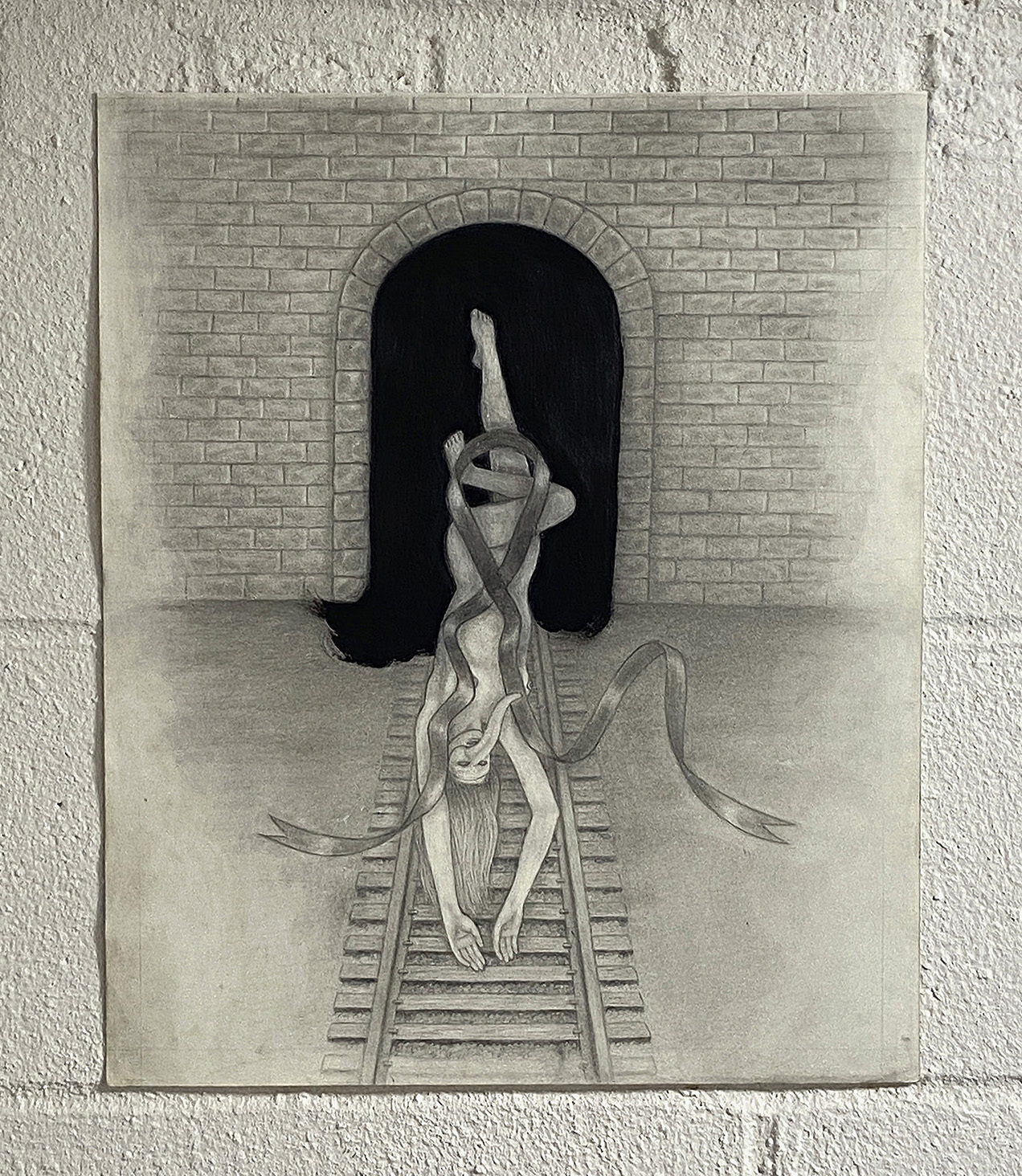 Train Tracks (detail) © Dungeon Detroit
Train Tracks (detail) © Dungeon Detroit
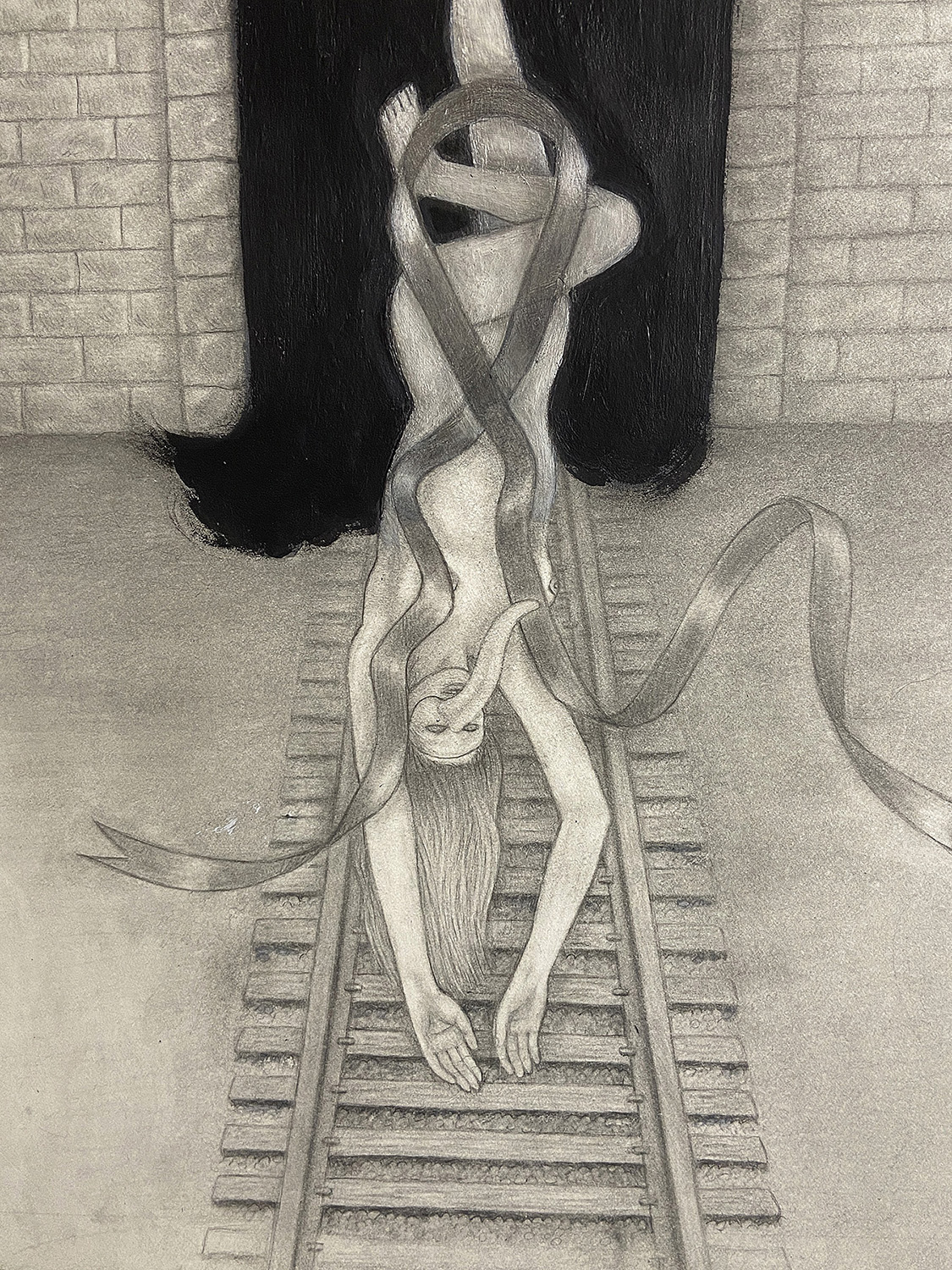 Train Tracks (detail) © Dungeon Detroit
Train Tracks (detail) © Dungeon Detroit
 Bower of Bliss (install) © Dungeon Detroit
Bower of Bliss (install) © Dungeon Detroit
Just as “both Edmund Spenser and William Shakespeare used folklore concerning The Fairy Queen to create characters and poetry, Spenser in The Faerie Queene and Shakespeare most notably in A Midsummer Night’s Dream” 1, in this body of work, Madeline Kuzak summons these old characters to create a more up to date rendition / interpretation of the story of The Faerie Queene by Edmund Spenser. She places the characters, originally from the Elizabethan era, into our 21st century clothing and using our 21st century technology. By doing this, Kuzak not only brings those characters through time to exist now, but also allows us, who live in this time, to enter a narrative that has been around for hundreds, if not thousands, of years.
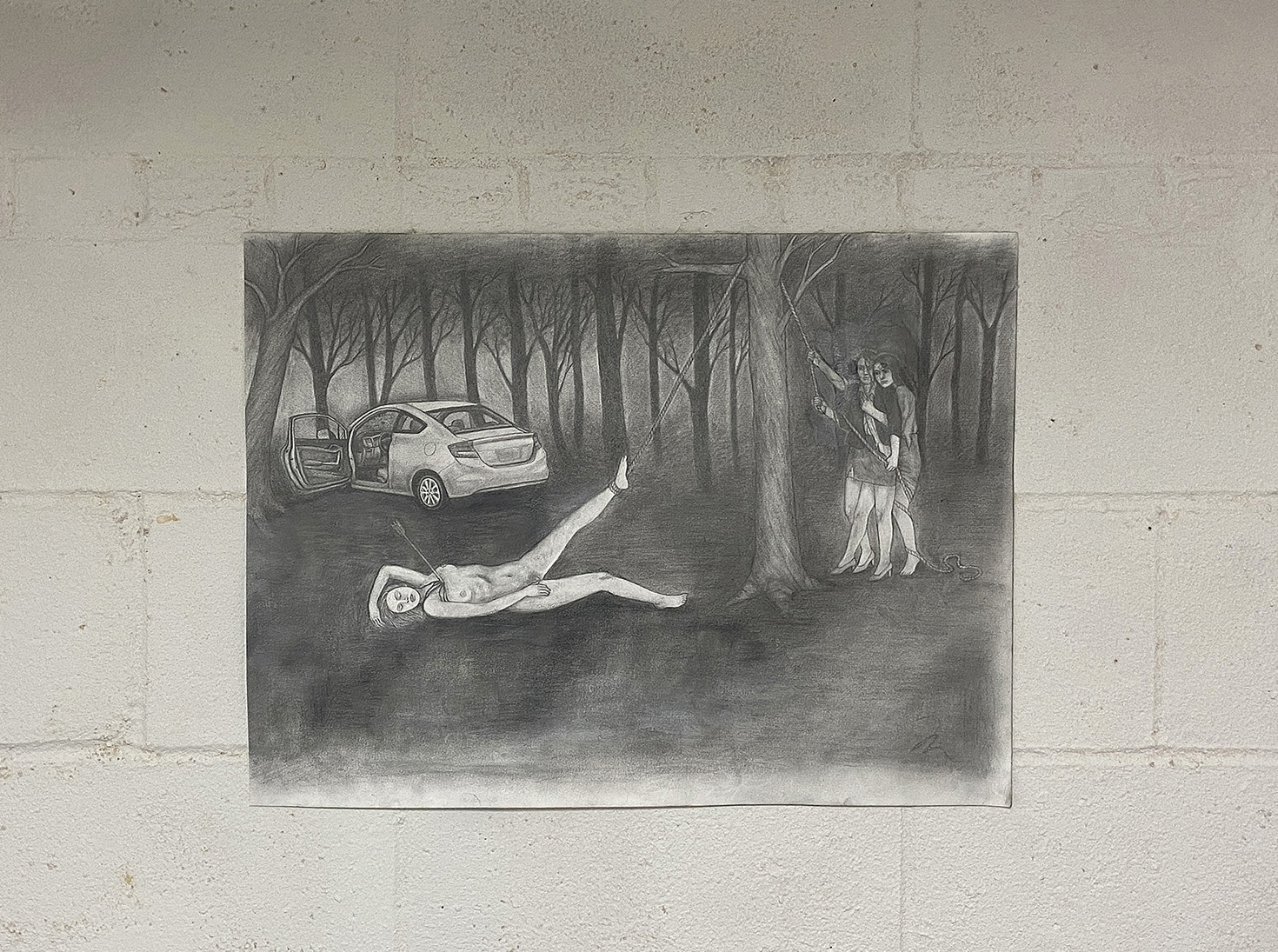 Bower of Bliss © Dungeon Detroit
Bower of Bliss © Dungeon Detroit
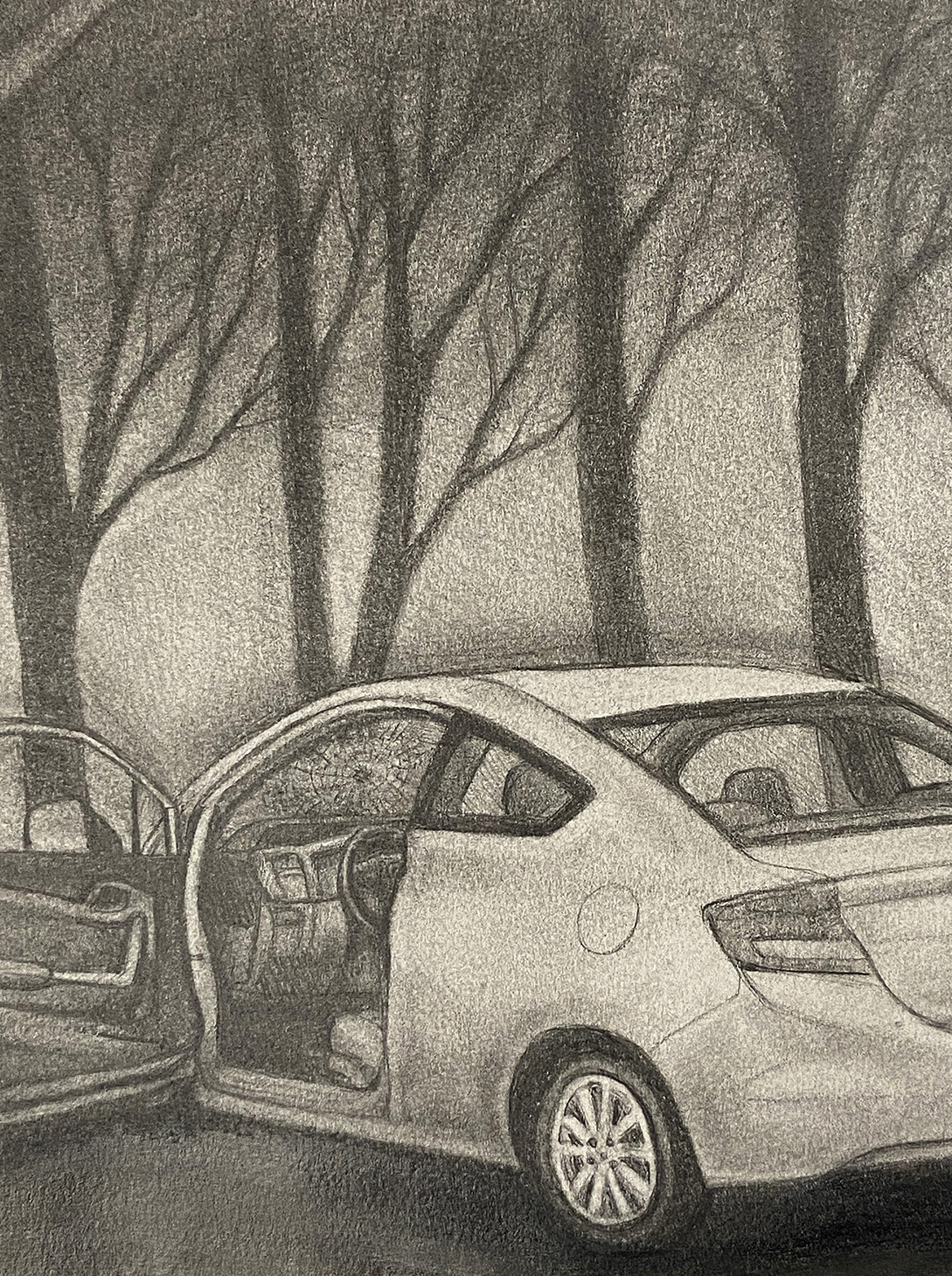 Bower of Bliss (detail) © Dungeon Detroit
Bower of Bliss (detail) © Dungeon Detroit
The magic and power of folklore is that it transcends space and time and actively mystifies the world around us, allowing us to participate in narratives, with all of its characters and locations, just as our ancestors did so many generations ago. Folklore blends the boundaries of our relationship to time and space, but also to animals, objects and the spirit world, often incorporating magic and ideals of good and evil. Many stories have been maintained from generation to generation as a way to respond to traumatic events of the time, teach children about sin and scare them into upholding certain values in avoidance of a confrontation with the horrendous experiences of darkness, in its many forms.
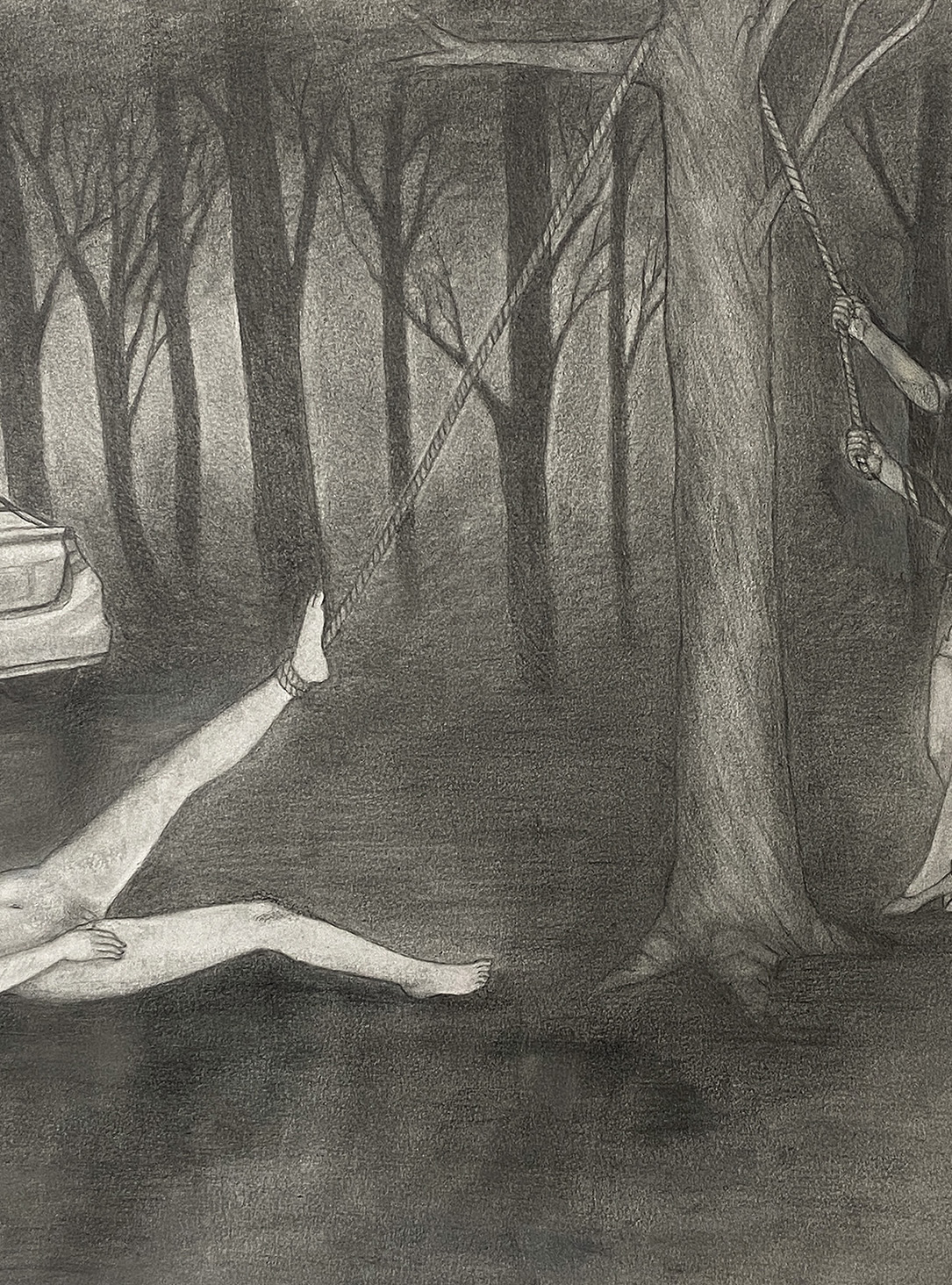 Bower of Bliss (detail) © Dungeon Detroit
Bower of Bliss (detail) © Dungeon Detroit
Although folklore has never really gone away, I have noticed a particularly strong resurgence of it amongst the Millennial generation, which has fostered specific groups who have developed a fascination for darkness and storytelling. What is the most interesting is not only the re-use of traditional stories, but the invention of new ones. What is the root of this new resurgence and what role has the internet played in the invention or perpetuation of new forms of folklore? “By drawing on folkloric traditions from around the world, and crafting their own universe-specific lore, video game writers and developers are building new interactive spaces for folklore and reifying the significance of folklore within our cultural imagination. Internet related and generated urban legends such as Slender Man also demonstrate the importance of cyberlore and the transformation of folklore in the digital age.” 2
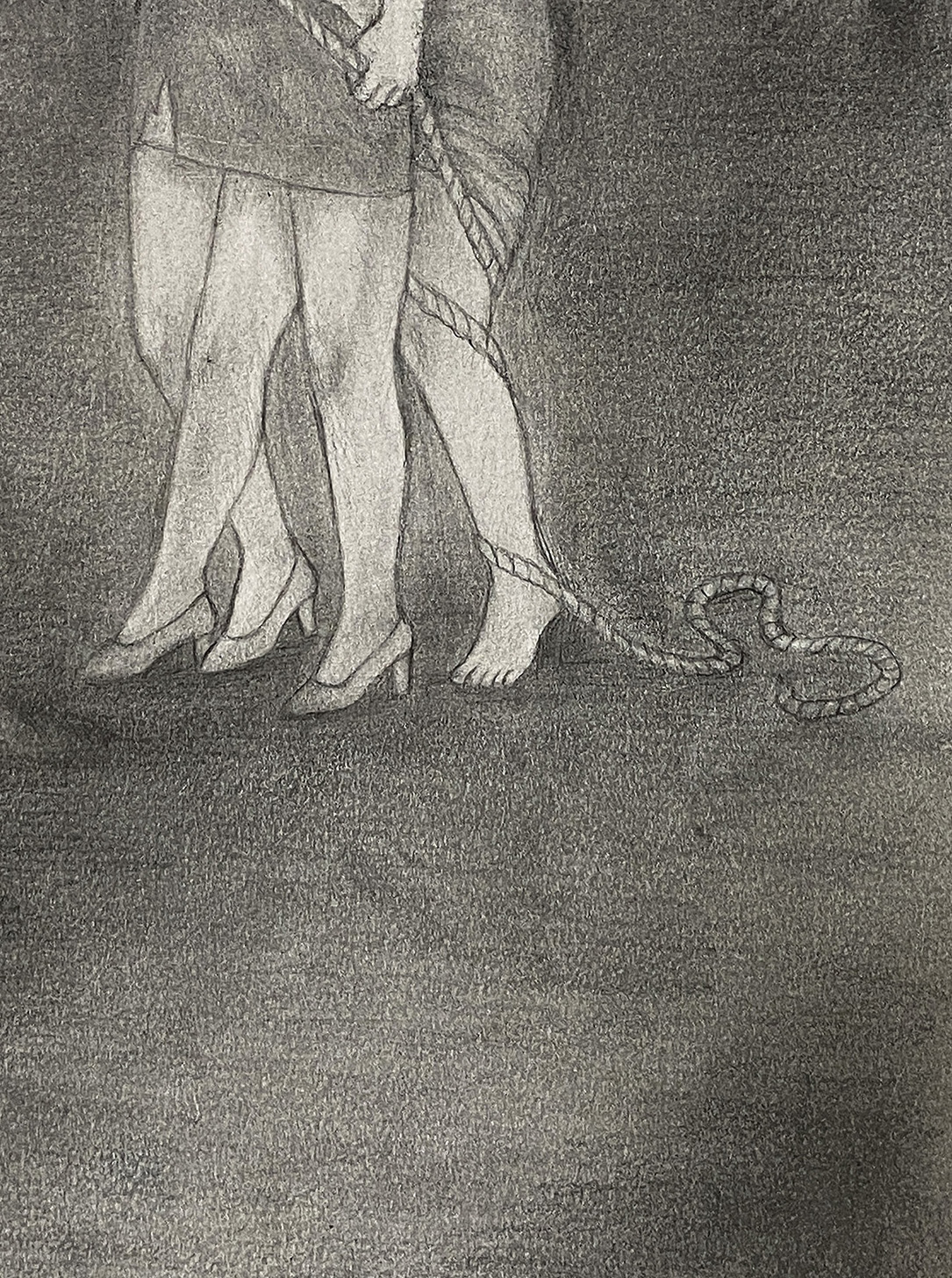 Bower of Bliss (detail) © Dungeon Detroit
Bower of Bliss (detail) © Dungeon Detroit
“Video games are increasingly drawing upon historical traditions of folklore to supplement their world-building, while also implementing elements of folklore and folklife to craft novel lore for their fictional universes. As video games often involve immersive storytelling within an entirely fictional setting, the veracity of the constructed world is amplified and deepened through a convincing video game lore….One of the most interesting elements of digital folklore is the creation of internet urban legends or ‘stories of unusual, humorous or horrible events that contain themes related to the modern world, are told as something that did or may have happened, variations of which are found in numerous places and times, and contain moral implications.’” 3
The creation and dispersion of some contemporary folklore amongst the youth can be found on websites like Creepypasta, featuring stories by writers that have driven followers to act upon their beliefs and fears in ways from creative to horrific. Without going into detail, I will say that the way that some of these folkloric stories have impacted the real world has proven to be more than just entertainment, “demonstrating the power of cyberlore and the role folklore still plays within our modern lives, leading us to question distinctions between ‘everyday life’ and the unreal, distinctions that may be made even more ambiguous by the bewildering variety of alternative realities found online.” 4
“As a fundamental human capacity and need...the production of folklore to represent tradition is a continuous vital force, and it is imperative to view how it is enacted with, and problematized by, media, old and new. Indeed, we may comprehend the way, in a new wired age, folklore is digitized and virtualized, or we may folklorize the age, perhaps outside our awareness.” 5
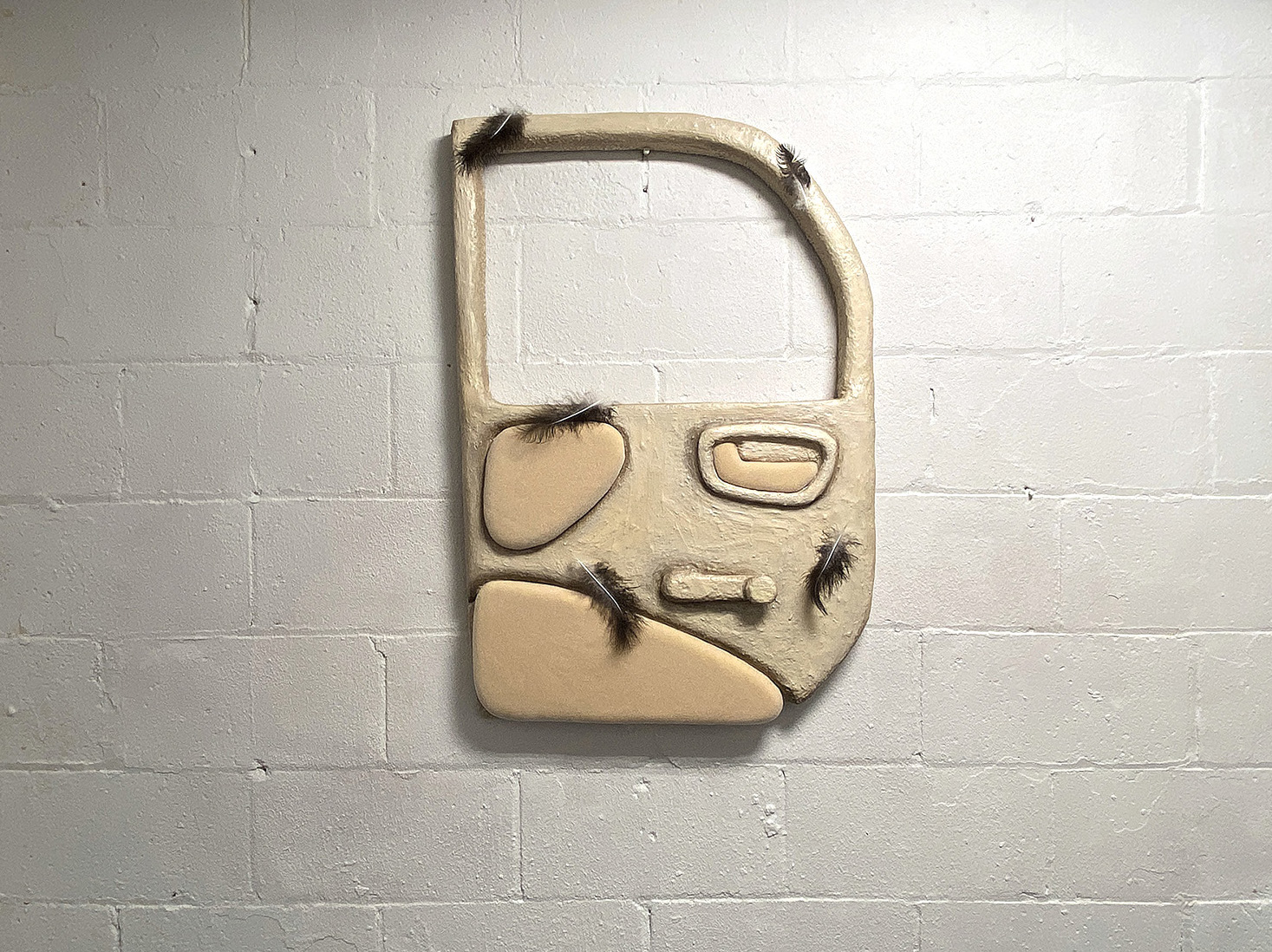 Car Door © Dungeon Detroit
Car Door © Dungeon Detroit
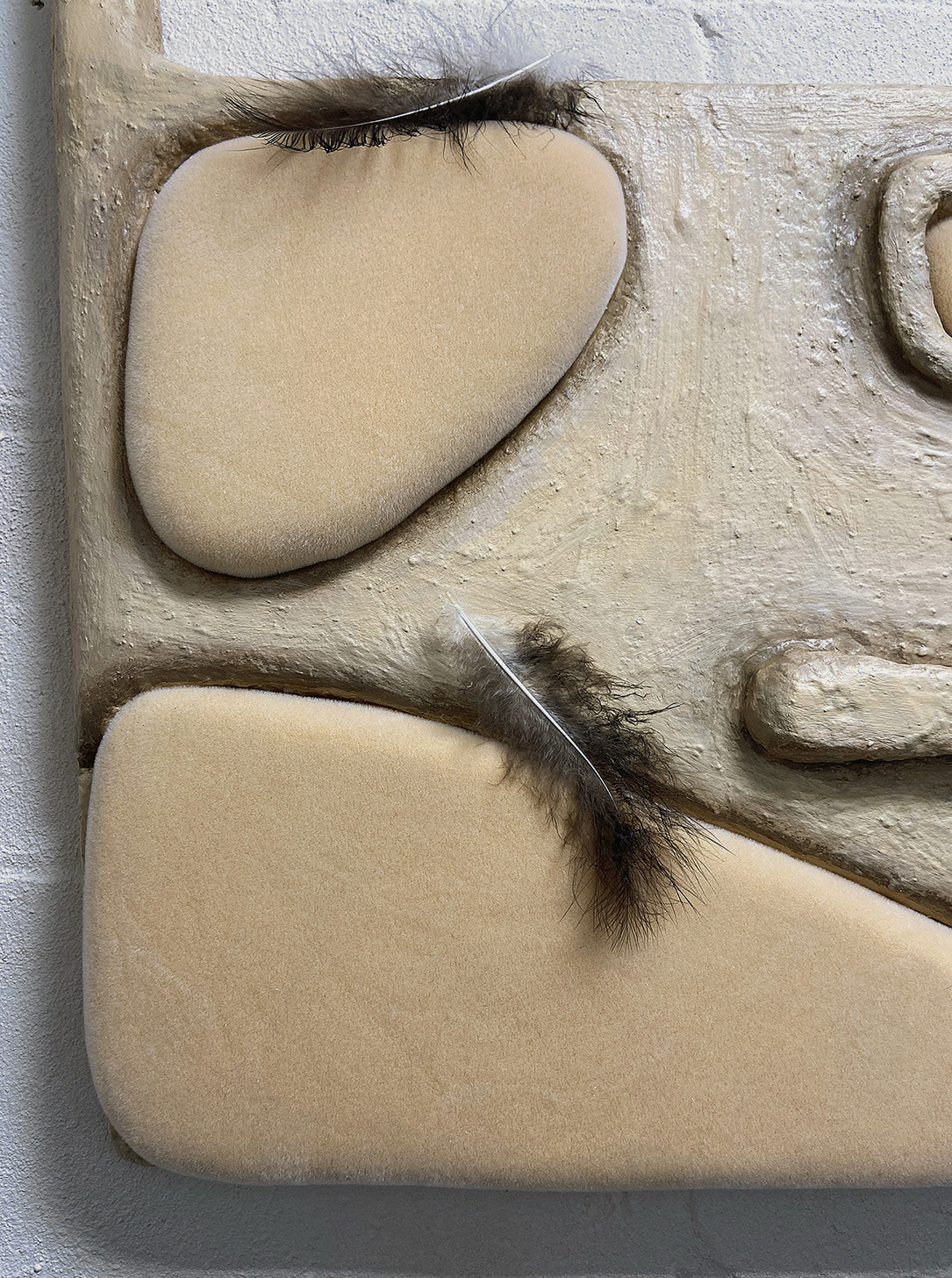 Car Door (detail) © Dungeon Detroit
Car Door (detail) © Dungeon Detroit
How does Kuzak’s work participate in this new wave or resurgence of folklore? An interesting point to make regarding “cyberlore” in relation to Kuzak’s work, is her high attention to detail and convincibility of her techniques in image and object making. As the gamers use cyber space to create a reality that mimics our outside world, and inserts these mythical elements into it to make us feel like we are experiencing it directly, Kuzak’s work, in its “realness”, does that, but in our actual real world. Through the imagery but also through the use of materials, with some materials being relatively raw and seem like they may have literally been plucked out of a storybook, there are others that take on a more set-design aesthetic, or like a movie makeup artist, all working, in their own way to merge the visual components of past and present, mythical and real.
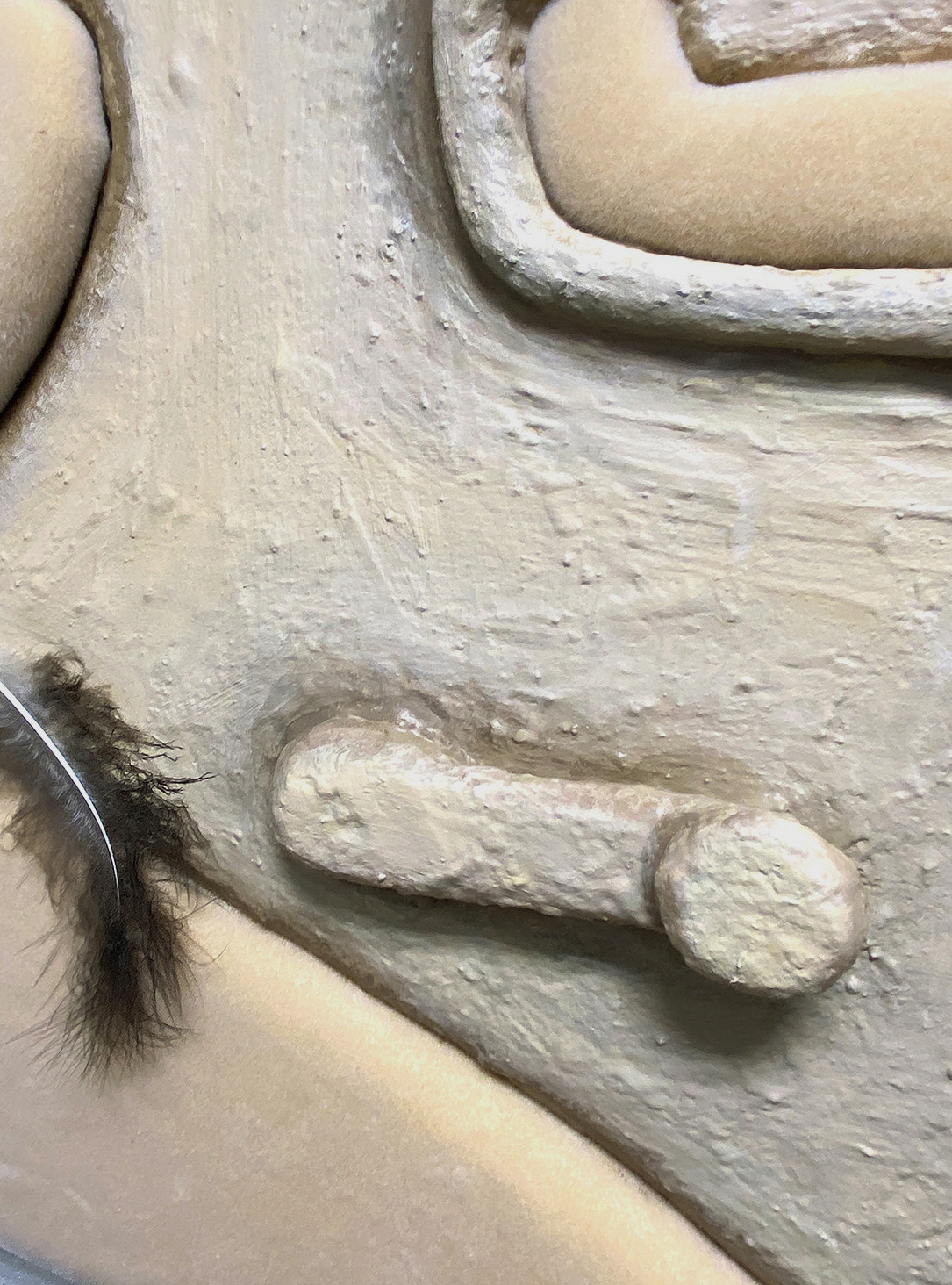 Car Door (detail) © Dungeon Detroit
Car Door (detail) © Dungeon Detroit
Dungeon Detroit is an exhibition space that is only accessible online, which even further magnifies this works relation to contemporary folklore and cyber-lore. Historically, folklore has been told through a variety of different forms; “including folktales, myths, legends, songs, dances, food recipes, and traditional artistic techniques,” 6 but “folklore is not something one can typically gain in a formal school curriculum or study in the Fine Arts. Instead, these traditions are passed along informally from one individual to another either through verbal instruction or demonstration...As new groups emerge, new folklore is created…surfers, motorcyclists, computer programmers. In direct contrast to high culture, where any single work of a named artist is protected by copyright law, folklore is a function of shared identity within a common social group.” 7
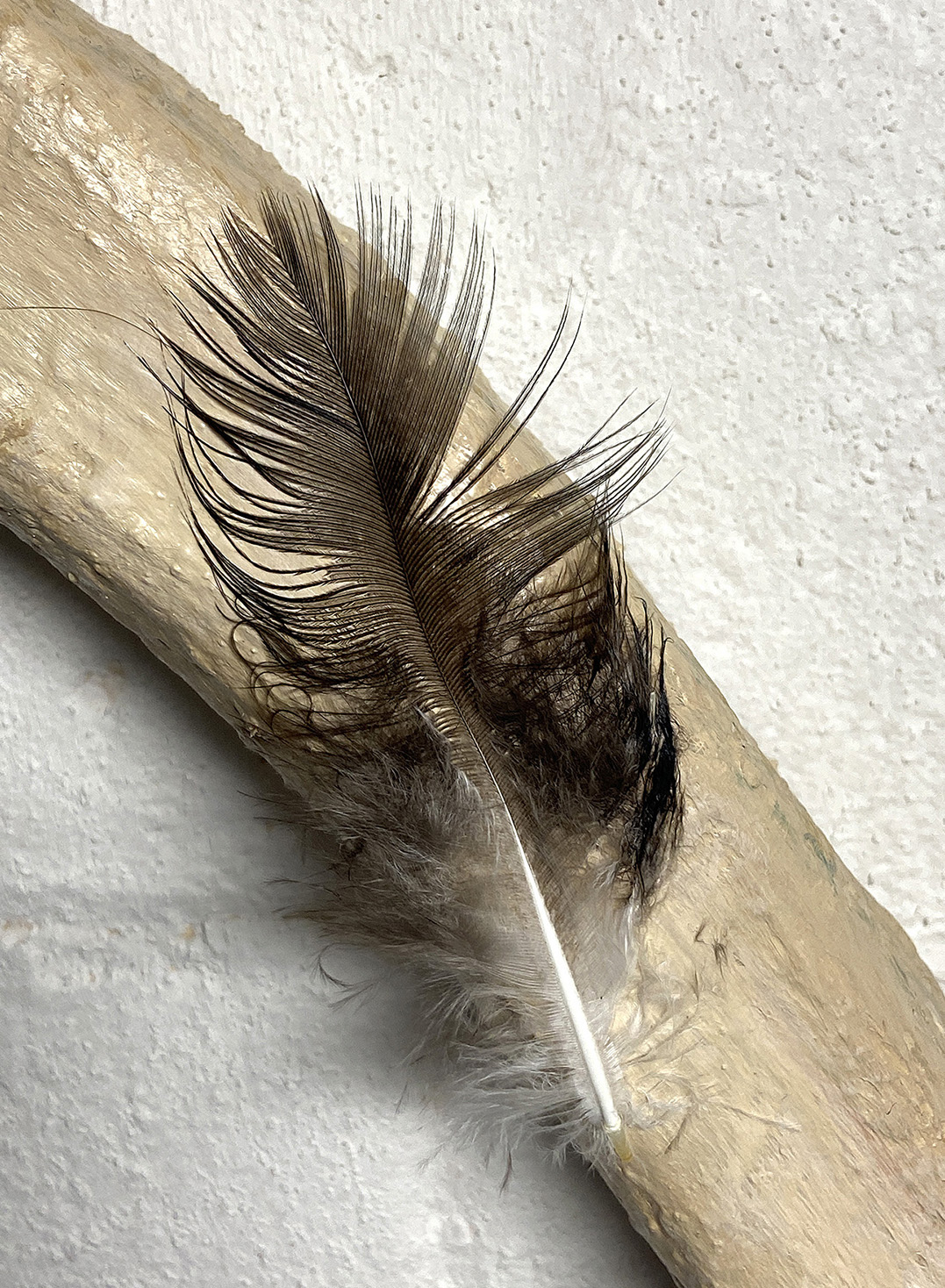 Car Door (detail) © Dungeon Detroit
Car Door (detail) © Dungeon Detroit
In looking at the overall work of Madeline Kuzak from exhibition to exhibition, there is a steady reminder of how, and where, folklore continues to exist. She uses methodologies that bring it into the contemporary art realm, with careful choices on where she decides to exhibit and a careful awareness of the environment where the work is being installed. Through this awareness of material and space, her work is activated by the environment just as the environment is activated by the work. The way in which some of her works are made carefully balances it between the realm of “high art” and art brut, whose history utilizes symbolism and decision making that is deeply personal to the artist. This distinct appreciation and homage to folk art also comes through in her use of raw or modest materials, like wood, charcoal drawings, or even using non-traditional art materials. Although Kuzak’s work does teeter into this realm of “outsider art” or “art brut”, it is aware of this as an aesthetic tool. It highlights a very interesting phenomena happening in this generation of storytellers, this resurgence of folklore, and consciously or unconsciously, also brings up questions of how and why it is taking place amongst kids of the Millennial generation.
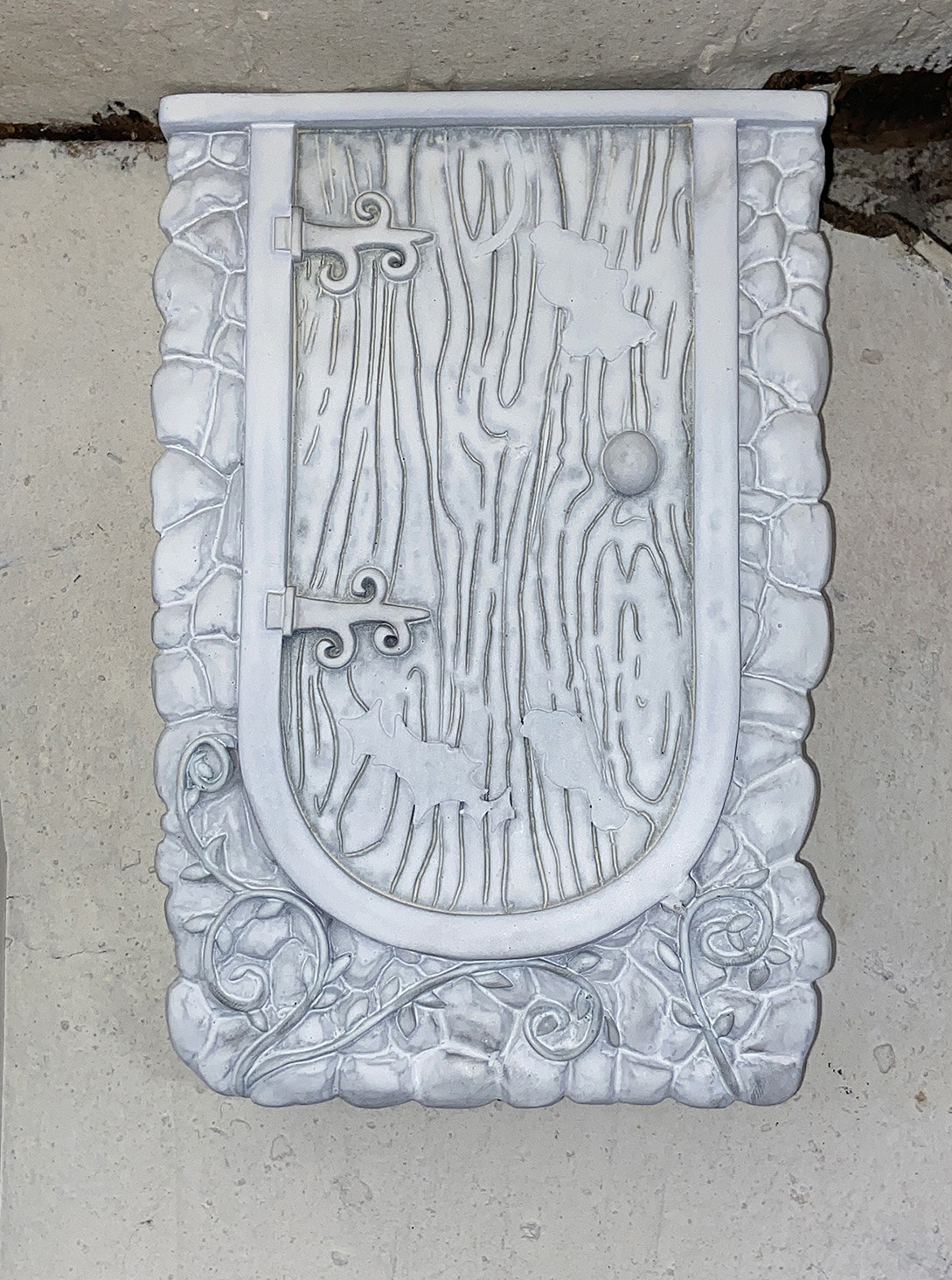 Fairy Door © Dungeon Detroit
Fairy Door © Dungeon Detroit
 Fairy Door (install) © Dungeon Detroit
Fairy Door (install) © Dungeon Detroit
Perhaps this resurgence of darkness in storytelling amongst the youth comes from an infatuation with a perspective that is rooted in the music, style of dress, or overall lifestyle of Goth culture? But it could also be perpetuated, on a broader scale, by the generational trauma resulting from the unending mourning of school shootings, climate change, or 9/11 and other events of domestic and global terrorism. There are a number of other contemporary artists who demonstrate similar points of view, approaching their practice through their nostalgia for childhood and a covert or open expression of frustration towards the “adults” of the world.
While experiencing a significant lack of trust or faith in the older generations due to the incessant violence and the lack of responsibility taken to keep the youth safe from this violence, it brings about a sense of loneliness and worry, or at least a very frustrated or apathetic generation of kids. Many seem to be consciously and actively assuming a much less rapid abandonment of childhood than would typically take place when a young human becomes an adult. Perhaps this is an effort to finally project the voice for our child-selves , who have never felt heard or taken seriously by the older generations. Well anyways, besides this more personal interpretation of mine, Kuzak provides insight into the work of this specific exhibition to help guide the interpretation of the show; a reflection on an excerpt from Camille Paglia’s Sexual Personae.
“Bower of Bliss is an enchanted setting in the epic poem The Faerie Queene by Edmund Spenser. In her book Sexual Personae, Camille Paglia theorizes that Spenser’s bower of bliss represents a feminine space of sexual domination: a shady, womb-like enclosed area where the hero is seduced away from his quest and kept in a state of ‘languid indolence and passivity’ by a sorceress who erotically drains his energy.” 8
It becomes apparent that this work is touching on the contemporary and historical perception of the powers of women. Like the sirens from Homers’ Odyssey 9, witches, or other seductive female characters throughout the history of folklore, there has been a continuous rendition of the woman as a distraction or detriment to the journey or mission of the man. 10 And these kinds of perspectives on woman are what have led, either directly or indirectly, to brutalism of women throughout the ages. But, through the development of their characters, Shakespeare and Spenser both express their love for “imperious and volatile women” 11. As The Faerie Queene became a staple of English Renaissance literature, so the liberated woman became a symbol of the English Renaissance…”In The Faerie Queene, we see her in free movement. I speak, of course, of artistic projection and not the life of real British women. But art is what transcends and survives. Of all truths, it is the finest.” 12
“In creating an evil Bower of Bliss...Spenser shapes his poetics to expose the reader’s own status regarding the virtue of temperance. The first eleven cantos of Book II presumably provide an education in properly temperate behavior, until the beauty of the Bower suddenly reveals that the reader prefers the seductive attractions of the wanton maidens and the leisurely raptures of Acrasia’s bed of roses to the moderation and rationality of Alma’s House of Temperance. As the reader responds to the descriptions of Acrasia’s garden, he shows how easily he can be seduced by the apparent beauties of earthly bliss-even though he knows the consequences of such intemperate actions. In the Bower of Bliss, the reader discovers that knowledge of evil and declared preferences for abstract virtue offer no protection against temptation. Through his response to the poetry, he finds himself in an embarrassing confrontation with his human nature.” 13
While Kuzak celebrates this observation of the imbued power of the female in this piece of literature, there is also present a feeling of push and pull, as if to illustrate broader observations of the woman’s conflicted role. Each of the four different women characters in this exhibition seem to be in a state of crisis, with some holding power and perpetuating violence, while another floating either in or out of control, and the other falling victim, completely without control of her situation. This could also be a representation of the various states of mind one enters when experiencing overwhelming sexual pleasure.
This “damsel in distress” in the center of Train Tracks floats freely upside down, with her naked body partially covered by a free-floating awareness ribbon, seeming to be waiting in front of the tunnel of a thick seeping darkness. She is wearing a Venetian mask. “In addition to theatrical productions, the long nose Venetian mask was also prominent during one of the most tragic periods of Venetian history, the Plague. The masks took different forms, but the beaks were always filled with heavily aromatic plants that were known to clean the air in this respiratory area of the mask, which was utilized by local plague doctors while treating plague patients.” 14 The symbolism is familiar enough to relate to, yet quiet enough to ponder with curiosity, and continues into the other works through the use of different symbols, encouraging us to fill in the gaps of an allusive story being told.
“Madeline Kuzak is an artist living and working in Detroit, Michigan. She received a B.A. in Art from Wayne State University in 2018. Recently, she had a solo show at darkZone in New Jersey and participated in a group show at ASHES/ASHES in NYC. Recent exhibitions include: We’ve Always Been Here, SOUTHFIELD (Southfield, MI); Limited too, in lieu (Los Angeles, CA); people moving through things and things that make people move, curated by Ethan R. Tate, Kate’s Little Angel (Los Angeles, CA); perception is more important than reality, curated by Dylan Spaysky, Greenroom Gallery (Detroit, MI).
Dungeon is a small subterranean room that serves as a satellite exhibition space for local & non-local artists, located in a domestic residence on Detroit’s east side. The purpose of Dungeon is to give visibility to works by emerging / experimental artists, and to help foster critical dialogues around contemporary art & society. An eerie energy is suspended in the space, which was originally built to function as a bomb shelter during the early 1900s. By repurposing this room as a gallery, Dungeon seeks to provide an alternative outlet for artistic communication in Detroit & worldwide.
1. Wikipedia. “The Fairy Queen.” Last modified December 27, 2020
2. Emma Louise Backe, “Contemporary Folklore in the Digital Age,“ October 3, 2014, The Geek Anthropologist, https://thegeekanthropologist.com/2014/10/03/contemporary-folklore-in-the-digital-age/
3. “Contemporary Folklore in the Digital Age,“
4. “Contemporary Folklore in the Digital Age,“
5. “Contemporary Folklore in the Digital Age,“
6. “Contemporary Folklore in the Digital Age,“
7. Wikipedia. “Folklore.” Last modified January 1, 2021“
8. Camille Paglia. Sexual Personae. (New Haven: Yale University, 1990), 187-188.
9. Ancient History Encyclopedia, 2009 ed., “Siren.” Last modified April 16, 2015
10. Emily Othic, “Sirens: The Portrayal of the Female Figure as Dangerous for Men’s Health.” The University of RoeHampton: Gods and Heros of Classical Mythology, 2017-2018 ed., Published July 1, 2017.
11. “Sexual Personae”
12. “Sexual Personae”
13. Arlene N. Okerlund, “Spenser’s Wanton Maidens: Reader Psychology and the Bower of Bliss,“JSTOR, PMLA (1973)
14. “Why Plague Doctors Wore Strange Masks” video file, 3:05, YouTube, posted by Smithsonian Channel, August, 8, 2019, https://www.youtube.com/watch?v=fpmQAISx_HQ.